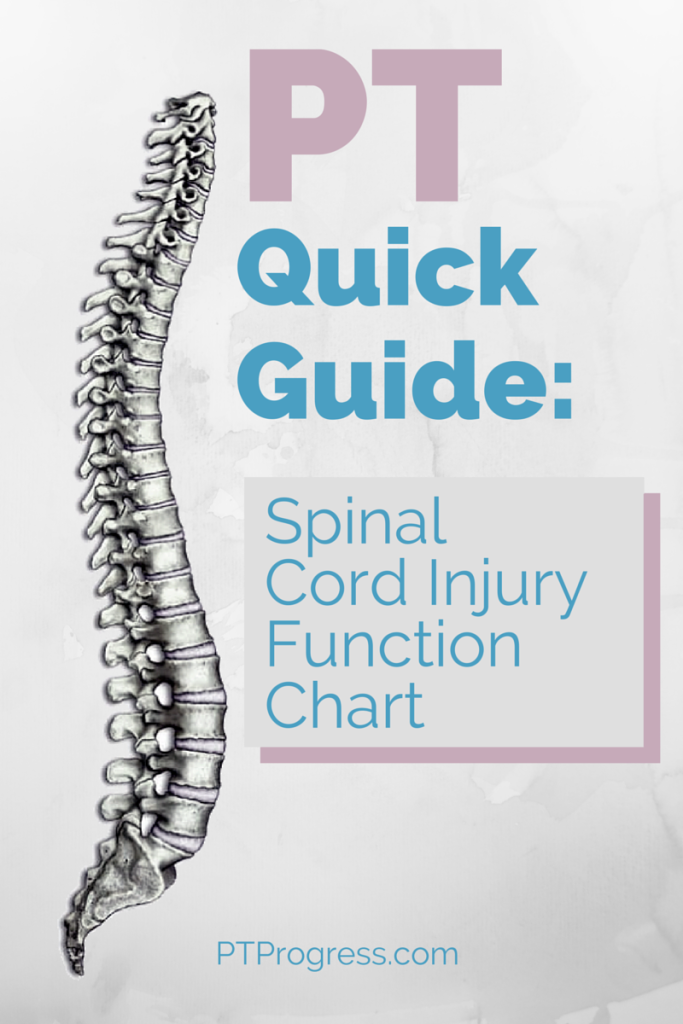
Usually the terms ‘incomplete’ or ‘complete’ are used to describe spinal cord injuries. You’ll also hear the level of the spinal cord injury (SCI) described , as in “Incomplete C5” or “Complete T1”.
These terms are used to describe the area of the spine that has been injured. Here are the possible areas of injury for spinal cord injuries:
C = Cervical Spine (C 1-7)
T = Thoracic Spine (T 1-12)
L = Lumbar Spine (L1-5)
S = Sacrum
Spinal cord injuries are very different and recovery of muscle groups can vary depending on the level and the ‘completeness’ of the injury. As it sounds, an incomplete injury at C5, for example, may result in partial motor or sensory below the level of C5. If the injury was complete, motor or sensory below C5 would be absent.
What is the ASIA scale?
The ASIA scale stands for the American Spinal Injury Association scale and is used to describe the level of a person’s spinal cord injury. The ASIA level helps to determine future rehabilitation potential and is based on sensory and motor tests ideally performed within the first 72 hours of injury.
ASIA Impairment Scale (AIS)
A = Complete. No sensory or motor function is preserved below the level of injury. Includes sacral segments S4-5
B = Sensory Incomplete. Some sensation is preserved, but no motor function is preserved below the level of injury. Includes sacral segments S4-5
C = Motor Incomplete. Motor function is preserved below the neurological level of injury and the muscles have a muscle grade less than 3.
D = Motor Incomplete. Motor function is preserved below the level of injury and at least half of the key muscle functions below the level of injury have a muscle grade greater than or equal to 3.
E = Normal. Motor and sensory function are normal in all segments.
Key Muscle Functions By Spinal Cord Injury Level
Knowing the spinal cord level and the ASIA impairment score, you should have a good idea of the potential for functional recovery. Incomplete injuries are variable so, the recovery really depends on the person. However, for a complete SCI, the level of injury gives us a lot of information about the muscle groups that are still functional.
At each higher level, the prior level of functioning muscles should be considered functional or potentially rehabilitative as well.
C 1-3 Spinal Cord Injury
Functioning Muscles Include:
Infrahyoid – depresses hyoid, aiding tongue movement and swallowing
Head and Neck Extensors
Rectus capitus, anterior and lateral – neck flexion and side bending
Sternocleidomastoid – neck extension, flexion, rotation, and side bending
Longus Colli and Capitus – neck flexion
Scalenes – neck side bending
C4 Spinal Cord Injury
Additional Functioning Muscles:
Trapezius – shoulder elevation
Upper Cervical paraspinals – neck flexion, extension, and lateral flexion
Diaphragm – respiration
C5 Spinal Cord Injury
Additional Functioning Muscles:
Rhomboids – scapular adduction
Deltoids – shoulder abduction, flexion, extension, rotation
Rotator Cuff (partial) –shoulder abduction
Biceps – weak elbow flexion and forearm supination
Brachialis, Brachioradialis – elbow flexion
C6 Spinal Cord Injury
Additional Functioning Muscles:
Rotator Cuff (full innervation) – full rotation and abduction of shoulder
Serratus Anterior – scapular abduction and upward rotation
Clavicular Pectoralis Major – Shoulder horizontal adduction
Biceps – full strength elbow flexion
Extensor Carpi Radialis – wrist extension (Tenodesis can occur)
C7 Spinal Cord Injury
Additional Functioning Muscles:
Latissimus Dorsi – shoulder internal rotation, adduction, depression
Pectoralis Major (sternal head) – shoulder internal rotation, adduction, depression
Triceps – elbow extension
Pronator Teres – forearm pronation
Flexor Carpi Radialis – wrist flexion
Flexor Digitorum Superficialis – some finger flexion
Extensor Digitorum – finger extension
Extensor Pollicis – thumb extension
C8 Spinal Cord Injury
Additional Functioning Muscles:
Flexor Digitorum Profundus and Superficialis – finger flexion
Flexor Pollicis Longus and Brevis – thumb flexion
Abductor Pollicis Longus – thumb abduction
Opponens Pollicic – thumb opposition
Adductor Pollicic – thumb adduction
Partial Lumbricals – flexion at the MCP joints with extension of IP joint
Flexor Carpi Ulnaris – wrist flexion
Extensor Carpi Ulnaris – full wrist extension with adduction and abduction
T1 – T6 Spinal Cord Injury
Additional Functioning Muscles:
Dorsal and Palmar Interossei – finger abduction and adduction of the IP joint
Abductor Pollicis Brevis – thumb abduction
Full Lumbrical function – MCP joint flexion with IP joint extension
Erector Spinae of upper back – thoracic spine extension
Upper intercostals – inspiration and some forced expiration
T7 – T12 Spinal Cord Injury
Additional Functioning Muscles:
Abdominals – partial to full innervation for trunk flexion and rotation
Quadratus Lumborum – partial innervation, weak pelvic elevation.
L1 – L2 Spinal Cord Injury
Additional Functioning Muscles:
Quadratus Lumborus – full innervation, pelvic elevation
Iliopsoas – hip flexion
L3 – L4 Spinal Cord Injury
Additional Functioning Muscles:
Quadriceps – knee extension
Lower Erector Spinae – lumbar extension
Partial Hamstrings – knee flexion
Adductor muscles – hip adduction
Anterior Tibialis – weak ankle dorsiflexion
The list above is for reference only. Consult with a physician or physical therapist for a full neurological evaluation.


VERY helpful. Thanks so much
Thank you this quickie refresher was just what I needed to answer my question. Great information
That is just terrffic!!! Thanks indeed!!!!